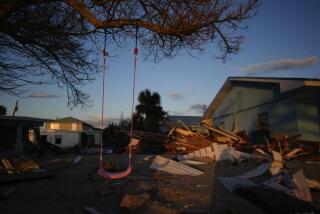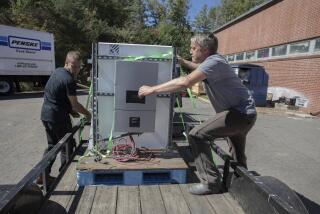Pride and pain duel a year after town’s deadly twister
JOPLIN, Mo. — Arielle Speer started to cry. She was having a panic attack, and the movie hadn’t even started.
Speer is a Joplin tornado survivor, and she had come to remember. Almost a year ago, the 28-year-old was standing on the side of Connecticut Avenue looking at the pile of rubble that used to be her apartment building. It had since been cleared away, and now Speer was sitting in a local university auditorium, waiting to watch a documentary about the storm that destroyed it.
A lot has happened since May 22, 2011, when a massive tornado erased nearly a third of Joplin and killed about 160 people. The recovery has been long and painful and remains incomplete.
For Speer, the film will become a necessary piece of evidence that she can show the world to explain what happened to her.
“It validated my crazy behavior after the storm,” she said in the lobby after the show, clutching a $20 DVD she’d bought but wasn’t quite sure when she’d watch again. “Even my mother — who was in the city after the storm — she wasn’t inside the tornado. She didn’t understand my anxiety, my panic attacks. I actually left the city for eight months. Now I feel that everything I went through, it’s been wiped away.”
This is Joplin one year after the tornado — a knot of painful contradictions, like a patch of healing scar tissue still sensitive to the touch. The community is dedicated to these rituals of remembrance big and small, but it’s also a place moving beyond the disaster in increments.
New houses are sprouting up here and there in the disaster zone, and a public mythology has emerged — one of small-town unity and exceptionalism. The days-after-9/11 sort of story firmly holds that the best qualities of this gritty former mining town were brought out by the worst of the storm.
“No one is separate from the group, and that is what has gotten us this far,” City Manager Mark Rohr said of an upcoming public memorial, echoing a sentiment shared by many here. Call it survivor’s pride, but the emotion is less about what happened during the storm than the togetherness that happened afterward.
“I don’t think the tornado is Joplin’s identity,” said Jordan Magelssen, 23, a theology student at Ozark Christian College who rushed home from a mission in Jamaica after the storm hit. “I think it helped us see what that identity is.”
To Magelssen and others, that identity was one of faith, which so many residents of this deeply Christian town clung to during and after the tornado. The recovery effort, which drew volunteers from all over the Midwest and the U.S., was heavily driven by church groups.
The recovery has often been striking in its achievements. Joplin Public Schools kept the stubborn promise made immediately after the storm to start school on time in the fall, despite seeing eight schools damaged or destroyed in the tornado. The high school temporarily relocated to an empty outlet store at the local mall; there, it was quickly retrofitted with ad hoc classrooms and technological capabilities so impressive that the return to classes became a point of civic pride.
Inside the disaster zone, only nine weeks after the tornado, the U.S. Army Corps of Engineers had cleared about 90% of the 1.5 million cubic yards of debris thought to have been left by the tornado. A wasteland of plywood and brush piles once seemed to stretch from horizon to horizon in some parts of the city.
Yet the speedy repair efforts in some cases outpaced the psychological recovery. Consider the reconstruction along the city’s busiest business strip, which was demolished by the twister.
When winds topping 200 mph crumpled the Home Depot on Rangeline Road, the store became a massive concrete sarcophagus so impenetrable that the Missouri Task Force 1 — an elite rescue team — had to use saws and torches normally used to cut through hulls of submarines to reach corpses buried in the rubble.
Another Home Depot was built in its place within eight months. The ruined Wal-Mart and Academy Sports box stores also were rebuilt — almost as if the tornado had swept through only to make everything newer.
Ray Martin came to the Home Depot with his son recently to buy a few stones for a landscaping project. Looking at the shiny new store from the bed of his truck in the parking lot, he called it “extremely creepy.” He was not the only one to say so.
Seven people died there. Yet inside the rebuilt store, business now carried on as usual, and Carrie Underwood, or someone who sang a lot like her, played over the speakers.
Not everything is new. The city has issued more than $300 million in building permits, and the air is filled with the thrumming of construction crews, but much of the miles-long disaster zone is still barren.
Many owners have been slow to rebuild — a city board is threatening dozens of damaged structures with forced demolition — and some owners have decided to leave.
Chris Richardson has stayed. He lost his roof and his neighborhood in the storm but gained a driving range: a long stretch of grass that used to be a row of houses that leads down to the ruined husk of St. John’s Hospital.
He still doesn’t have water, but in the mornings, before the workers arrive to continue their demolition and cleanup work at the hospital — which the storm pushed 4 inches off its foundation — he likes to take golf balls and his driver and knock a few across 26th Street. “We call it redneck weed-whackin’,” he said.
He figures it’s 255 yards to hit the bottom floor, 270 yards if he sends one through the windows on the third. This is how he fills the bulldozed emptiness that surrounds his little red house at the top of the hill.
And though he’s put in thousands of hours to fix up his property, he’ll be left with at least one remnant of the storm whether he likes it or not.
“The only tree I wanted to cut down before this nightmare was that one right there,” he said, pointing to a crooked, runty 12- or 15-footer by his porch — the only one left in his yard. He laughed. “Now my mother says, ‘Don’t you dare touch that tree.’”
Arielle Speer went a step further. When she returned to the disaster zone and saw that her apartment had been bulldozed, she dug up a rose bush before the city could clear it away with the last of the building’s foundation. She put the bush in a pot, waiting for a chance to replant it. She needs to keep the past with her, even if it’s just a plant.
“It’s something they can’t tear up and wipe away,” she said. “It can last forever.”
More to Read
Sign up for Essential California
The most important California stories and recommendations in your inbox every morning.
You may occasionally receive promotional content from the Los Angeles Times.











